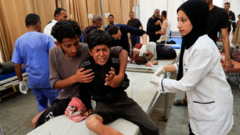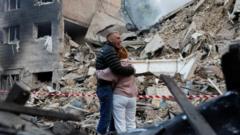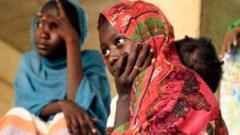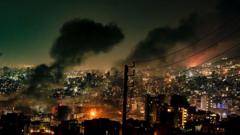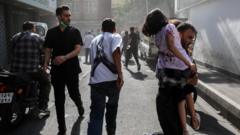The article sheds light on personal stories of loss amid the chaos, illustrating the struggles faced by survivors as they navigate through the rubble while survival efforts remain critically lacking.
**Desperate Pleas and Unseen Tragedy: The Aftermath of Myanmar's Earthquake**
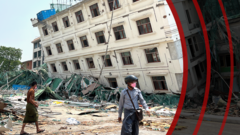
**Desperate Pleas and Unseen Tragedy: The Aftermath of Myanmar's Earthquake**
A stark look at the overwhelming devastation and inadequate aid for survivors following the earthquake in Mandalay.
Mandalay, Myanmar – The recent earthquake that rocked Mandalay has left a trail of devastation, with significant damage evident throughout the city. As the situation unfolds, eyewitness accounts reveal the despair of those affected, struggling to receive essential aid amidst a landscape of ruin.
Upon entering Mandalay, our team was met with an alarming sight: collapsed buildings littering the streets, particularly in northern and central districts—homes and businesses transformed into heaps of debris. Many structures showed severe fractures, posing a danger to anyone who dared enter. The main hospital is overwhelmed, forcing medical staff to treat patients outside under harsh conditions.
Myanmar's military regime has restricted access to foreign journalists seeking to cover the disaster, compelling us to enter the area without official clearance. We navigated cautiously, aware that informants are prevalent, doing the military's bidding to monitor and report on the population's activities.
Stranded in heart-wrenching agony, victims' families await news of their loved ones. Nan Sin Hein, a mother, clings to hope as she stands by a collapsed five-story building, awaiting information on her 21-year-old son, Sai Han Pha. She insists that if rescuers could reach him soon, he might still breathe. Trapped within the collapsing structure during a renovation work, Sic Han Pha remains missing.
With rescue efforts woefully inadequate, the underlying political turmoil exacerbates the crisis. Prior to the earthquake, Myanmar was plagued by civil unrest, with armed conflict displacing millions. This ongoing turmoil has hampered the government's ability to allocate appropriate resources for recovery and relief operations, leaving many areas untouched by rescue teams.
Despite a reluctant appeal from the military junta for international assistance, geopolitical tensions have hampered adequate aid from the major countries. Currently, only limited help is coming from select nations, mostly neighboring ones like India and China.
As rescue operations focus on high-density structures where victims might be trapped, conditions continue to deteriorate. In sweltering 40°C heat, teams painstakingly work against severe odds, uncovering the grim reality of loss. Many trapped have not been accounted for, with families enduring anguish while awaiting identification.
Traditional mourning rituals have emerged in the streets, as people gather to honor lost loved ones. The tragic fate of U Hla Aung and Daw Mamarhtay highlights the regularity of this suffering. Their family unearthed them after two days, found entwined in a final embrace. A memorial service held under brutal circumstances serves as a testament to the resilience of the human spirit amidst mourning.
The official death toll from the Myanmar government stands at 2,886, but this number lacks credibility due to the many locations still unassessed. Makeshift camps have sprung up around the city, with displaced residents sleeping outdoors on mats and mattresses. Families living in parks scramble for essential resources, receiving scant assistance from local donors.
Daw Khin Saw Myint, 72, exemplifies the desperate conditions faced by many, recounting how she and her granddaughter fled their home, only to find themselves without shelter and food. As she pleads for help, her grief is palpable as she contemplates their uncertain future following the destruction of their home.
While hospitals are strained, overwhelmed with casualties, family members must often fulfill caregiving roles, tending to the injured in the absence of adequate medical staff. Conditions remain dire, with more deceased arriving than survivors, as hopes gradually fade for many.
Nan Sin Hein's heart-wrenching wait emphasizes the impact of loss, as she grapples with the possibility of never seeing her son again. Each day passes with uncertainty and dread, as she wishes only to obtain closure, hoping against hope to see her son's face one last time.
Upon entering Mandalay, our team was met with an alarming sight: collapsed buildings littering the streets, particularly in northern and central districts—homes and businesses transformed into heaps of debris. Many structures showed severe fractures, posing a danger to anyone who dared enter. The main hospital is overwhelmed, forcing medical staff to treat patients outside under harsh conditions.
Myanmar's military regime has restricted access to foreign journalists seeking to cover the disaster, compelling us to enter the area without official clearance. We navigated cautiously, aware that informants are prevalent, doing the military's bidding to monitor and report on the population's activities.
Stranded in heart-wrenching agony, victims' families await news of their loved ones. Nan Sin Hein, a mother, clings to hope as she stands by a collapsed five-story building, awaiting information on her 21-year-old son, Sai Han Pha. She insists that if rescuers could reach him soon, he might still breathe. Trapped within the collapsing structure during a renovation work, Sic Han Pha remains missing.
With rescue efforts woefully inadequate, the underlying political turmoil exacerbates the crisis. Prior to the earthquake, Myanmar was plagued by civil unrest, with armed conflict displacing millions. This ongoing turmoil has hampered the government's ability to allocate appropriate resources for recovery and relief operations, leaving many areas untouched by rescue teams.
Despite a reluctant appeal from the military junta for international assistance, geopolitical tensions have hampered adequate aid from the major countries. Currently, only limited help is coming from select nations, mostly neighboring ones like India and China.
As rescue operations focus on high-density structures where victims might be trapped, conditions continue to deteriorate. In sweltering 40°C heat, teams painstakingly work against severe odds, uncovering the grim reality of loss. Many trapped have not been accounted for, with families enduring anguish while awaiting identification.
Traditional mourning rituals have emerged in the streets, as people gather to honor lost loved ones. The tragic fate of U Hla Aung and Daw Mamarhtay highlights the regularity of this suffering. Their family unearthed them after two days, found entwined in a final embrace. A memorial service held under brutal circumstances serves as a testament to the resilience of the human spirit amidst mourning.
The official death toll from the Myanmar government stands at 2,886, but this number lacks credibility due to the many locations still unassessed. Makeshift camps have sprung up around the city, with displaced residents sleeping outdoors on mats and mattresses. Families living in parks scramble for essential resources, receiving scant assistance from local donors.
Daw Khin Saw Myint, 72, exemplifies the desperate conditions faced by many, recounting how she and her granddaughter fled their home, only to find themselves without shelter and food. As she pleads for help, her grief is palpable as she contemplates their uncertain future following the destruction of their home.
While hospitals are strained, overwhelmed with casualties, family members must often fulfill caregiving roles, tending to the injured in the absence of adequate medical staff. Conditions remain dire, with more deceased arriving than survivors, as hopes gradually fade for many.
Nan Sin Hein's heart-wrenching wait emphasizes the impact of loss, as she grapples with the possibility of never seeing her son again. Each day passes with uncertainty and dread, as she wishes only to obtain closure, hoping against hope to see her son's face one last time.



